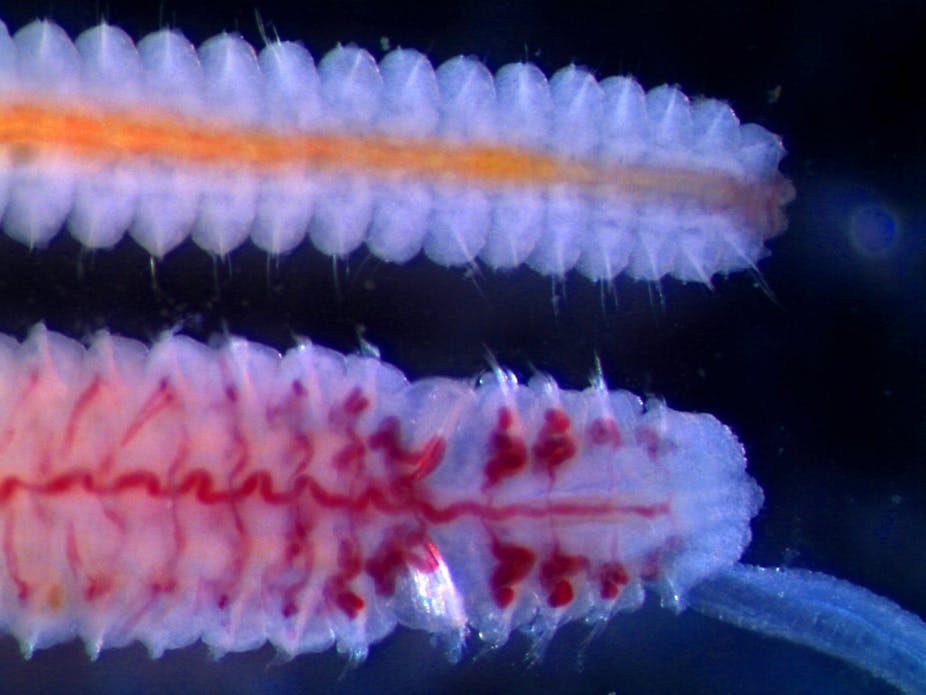Polychaetes are segmented worms that live in nearly all marine habitats, from the shallow seashore or estuaries to the deep sea. They are very abundant, often making up as much as 70% of the animals found in an area. Not only are there many of them, but they are very important in contributing to the biodiversity of the marine environment.
Many species of these worms – and there are at least 11,500 species worldwide – perform ecological functions similar to those of earthworms, their terrestrial relatives. They provide food for birds or fish, they recycle marine compost, and their burrowing keeps sand oxygenated.
Polychaetes also have a few unique functions. Some species create three-dimensional habitats for other animals when they build tubes that form reefs on rocks. Some are ferocious predators. Others bore into the shells of molluscs such as oysters and marine snails and the bones of dead whales. They turn the shells and bones into calcareous sand, or release calcium carbonate back into the environment where it can be incorporated into new shells.
Polychaetes can also have an economic impact when fishermen use them as bait or when they damage the shells of farmed oysters and abalone. And they can create ecological havoc when they invade new environments. This happens when they are accidentally moved around the world on the hulls of ships, in their ballast water, or as hitchhikers on oysters and other shellfish transported for farming.
Read more: How we found a way to track alien marine species along South Africa's coast
The first step in exploring the many ecological roles of polychaetes, and conserving them where necessary, is to identify the species. In South Africa this is complicated by the fact that it’s not known which, and how many, species actually occur on the country’s coast.
According to the definitive book on southern African polychaetes, written by John Day in 1967, more than 700 species have been reported in the region. But in the course of more recent research it was found that several species thought to occur throughout the world had been misidentified locally. They had to be described as new species. Describing is when the main features of the species are recorded and the species is given a name.
We therefore reviewed all species reported in the book to identify those that need to be investigated to confirm their identities.
Correct species identifications matter because an identification is more than a name. The name includes the “backstory” – where it lives, how it reproduces, how it interacts with other species in its habitat and ultimately, its ecological role and response to environmental changes or exploitation.
How many species need to be investigated
To identify the species that need to be investigated, we examined the literature for certain information for each species: when it was first described (old descriptions are not good enough to identify species accurately); where it was reported in South Africa and the rest of the world; whether it had ever been reported as an alien, a pest or as bait; and whether it had been misidentified in other parts of the world.

Our review estimates that more than half the species recorded in the book have probably been misidentified. Additionally, some species thought to occur along the entire coastline of southern Africa may actually be several species that look alike, each occurring in a separate stretch of coastline. We therefore calculated that at least 500 undescribed species are hidden among the 700 or so species reported in Day’s book. So there could be at least 1,200 species in South Africa.
Read more: Why plants need an identity
Correctly identifying species is essential for effective management and conservation. Shell-boring polychaete worms illustrate this point very well. More than half the shell-boring species on oyster and abalone farms in South Africa are alien. It’s possible that some, if not all, came into the country on molluscs imported for farming, and then moved between farms.
Different species may all damage their hosts in the same way. But alien species can be eradicated by killing the infested animals if they are only present on farms. And this can only happen if the species are correctly identified before they escape from farms and form large populations in the wild. Once this happens, they are impossible to eradicate, and pose a constant threat to farmed and wild molluscs.
Conservation of species collected for bait may be compromised if several species occupying different sections of the coastline are mistaken for a single widespread species. If one species is more vulnerable to exploitation than another, they may be managed differently. For example, the maximum number of worms that fishermen can collect per day of each species may differ to ensure sustainable harvesting.
Read more: The long struggle to understand species: from pre-Darwin to the present day
Correctly identifying species
Correctly identifying species is also important for conducting rigorous scientific research. It is essential that other researchers can repeat experiments to validate the results. But you cannot repeat a study conducted on one species if you are unknowingly investigating another species. Comparisons between different populations or investigations of a species become almost meaningless if the identity of the species is uncertain. This is especially important when investigating how species are affected by pollution or changes in environmental conditions.
But most importantly, it’s impossible to measure the rate of species extinctions in the face of global change or select biodiversity hotspots for conservation when you don’t know what species are present. Uncovering this hidden diversity is a job too big for the few polychaete taxonomists (researchers who describe and name species) active in South Africa. We need to train more local taxonomists and need help from international taxonomists.

